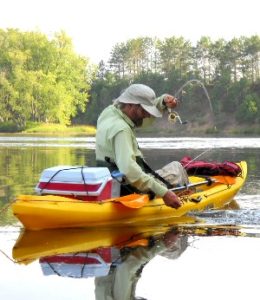Nowadays with so many lines on the market it’s easy to be confused on which best suits your type of fishing. This article takes a look at the various types of fishing line available and how they might perform for smallmouth bass fishing.
Don’t Go Cheap
A lot of fishermen make the mistake of selecting a pricey rod and reel combo and then skimping when it comes to spooling it up with line. Fishing line is one area you don’t want to skimp on. Look at this way, that line is the only link between you and that potential trophy smallmouth. Now, do you want a cheap no-name line, or would you rather spring for a little more money and have a top quality line between you and that bass of a lifetime?
While those huge spools of line available at the local “X-Mart” look pretty inviting and seem to be a great deal, nothing could be further from the truth. These lines have a good price, I will give them that, but their performance may not be up to snuff when you need it the most. This cheap line is notorious for having weak spots, being overly large in diameter and a tendency to be quite stiff. Those are three characteristics you don’t want in a line for smallmouth bass fishing.
Line Characteristics for Smallmouth Bass

Here Tim Holschlag battles hefty bronze using 8 pound test copolymer line.
So, what characteristics do you want in a line for smallmouth bass fishing? Personally, I prefer a line with small diameter, fairly limp, decent visibility above water, abrasion resistance and low stretch. The small diameter and limpness pretty much go hand in hand, and make for a line that handles easily on a spinning reel. Above water visibility is important because there will be many instances when your strike detection will rely on watching for the line to jump or move in an unusual fashion.
These last two characteristics are the most important in smallmouth fishing. The first is abrasion resistance. I think any line meant for smallies must be abrasion resistant. After all, their preferred habitat consists of rocks and rubble. This is not an environment for a wimpy line. You need to have a line that is going to stand up to repeated contact with rocks without weakening considerably.
The second line characteristic I prefer is low stretch. Less stretch makes the line more sensitive, allowing you better feel for what your lure is doing and detecting subtle bites. It also gives you a better hookset since more of your rod motion will be transferred to the hook point instead of being used to take the stretch out of the line.
The Line Families
There are four families of lines available right now. They consist of traditional monofilament, copolymer, fluorocarbon and the “super-lines”, which include braid and the fused lines. Each of these families has their own strengths and weaknesses which make them good for one type of fishing or another. The trick is to select a line which has the most strengths and the fewest weaknesses for your fishing.
For me, the two line families that have the best characteristics for smallmouth bass fishing are the copolymer lines and the super-lines. They have the most positives and the least negatives wanted in my lines. There is nothing wrong with the other line choices, any one of them would serve you well, and these two just provide the best compromise.
The Super-Lines
I personally use a braid from the super-line family for the majority of my fishing. It has almost no stretch, so the sensitivity is extremely good, and the hooksets are nothing short of phenomenal. It is has a very small diameter, which makes it very limp and easy to handle on a spinning reel. The only real weaknesses of this line are that it has a tendency to break easily when it comes up against sharp rocks. And you also can not use many of the traditional knots with super-lines because they will pull out when placed under tension. But, the good qualities of the line more than make up for these shortcomings.
It may sound like a whole hearted nod to super-lines as the line of choice for smallmouth bass fishing, but that is not case in all instances. If you are just starting out fishing for smallies, you may be better off starting with a copolymer line. I have started several people on their smallmouth fishing career and they have all had many problems adjusting to braid right off.
Why Copolymer is the Best Choice
The problem is the super-lines are a bit too sensitive. They literally give you the ability to feel every rock and pebble on the bottom, and this seems to cause a sort of information overload for new bronzeback anglers. They feel so much through the line that it causes confusion and makes it hard for someone just learning to tell the difference between an actual take by a fish, or if it is just another rock or log their lure is bumping.
For this reason, I recommend someone just getting started smallmouth bass fishing go with a copolymer line. It has more stretch to it so it is not quite as sensitive. This will allow you to get a good feel for what it actually feels like when a smallmouth takes your offering without having to deal with all the false alarms. The other benefit is that the copolymer is less likely to cut clean on a rock like braid can at times. This is mainly due to the stretch that allows it absorbed the abuse a little better.

This big smallmouth bass was caught on 8 pound test copolymer line.
Sizing Your Line
The next consideration is the pound test rating for the line. In the copolymer family the hands down best choice is 8lb test. It has enough strength to stand up to the rocks without breaking all the time. Lighter lines are more likely to break when rubbed across a rock because they just don’t have much reserve strength to handle the nicks and abrasions. A line break not only loses you a fish and a lure, it also leaves a fish out there with a lure stuck in its mouth. Not a good situation for any of the parties involved. Another problem with lighter lines is that they also have a tendency to stretch a bit more. As discussed earlier, excessive line stretch is not good because it reduces sensitivity and also weakens your hookset.
The 8lb test line gives the best compromise in low stretch characteristics without becoming too stiff to handle well on a smallmouth sized spinning reel. You could reduce stretch even more by going with a heavier line, like a 10 or 12 pound test, but these heavier lines are sometimes a bit too stiff to handle on a spinning reel.
Spooling Up the Fishing Line
The job of spooling up is a lot easier with the modern spinning reels that have a roller bearing on the bail. You used have to pay strict attention to how the line is coming off the filler spool and going onto your reel. Failure to do so would result in line twist being put in the line as you are spooling it on. This line twist causes the bird’s nest tangles that jump off the spool during a cast.
With a spinning reel fitted with the roller bearing you don’t have to worry about all that. You just spool line onto it just like you would a baitcaster, straight onto the reel from the filler spool.
A low-cost method is to use a pencil stuck through the hole in the filler spool. Just mount the reel to your rod and run the line from the filler spool through the first guide. Next, run the line under the bail and attach it your reel spool with a knot, I prefer the Arbor knot. Then enlist the help of another person to hold the pencil in their hands while placing a small amount of tension on filler spool while you reel the line onto your reel.
Going High-Tech with Line Spooling
If you want to be a little more high-tech, and be able to spool your reels by yourself, you can invest in one of the Berkley Line Stations (about $25.00). With this little gadget all you have to do is mount your reel on it and then mount your filler spool. The part that holds the spool has spring-loaded guides that apply the desired amount of tension on the line. Then all you have to do is crank the reel full of line and you are done.
Line Tips for Best Performance
Here are some additional tips for getting the most manageability, performance and life out of your line when spooling it up and when using it on the water:
- Fill your reel to a 1/8th of an inch between the line and the spool lip. Overfilling your spool can cause the line to dump off the spool during a cast, making a tangled mess.
- After filling your spool soak it for about 30 minutes in some hot water, about 115 degrees. This will set the line to your spool and remove all the filler spool “memory”. This is not necessary with braids.
- Close the bail of your reel by hand after making a cast. Turning the handle to flip the bail can introduce a loop in your line that will come back to haunt you later. It is also a good idea to give the line a slight outward tug after closing the bail and before beginning your retrieve. This removes any loose slack that could get reeled under the line.
- Use a swivel with lures that have a tendency to put twist into your line. Such as in-line spinners and fluke type baits.
- At the end of the day, remove the lure from your line and let out about 100 or 150 feet of line and troll it behind the boat at a low speed. This will remove any twist that was picked up during the day. If you are in moving water, you can just let out the line down stream and allow the current to pull out the twist.
- Retie often throughout the day. I usually do it every 30 minutes, or after catching a decent sized fish. Your line will pick up a lot of nicks and abrasions fishing around rocks that will weaken it significantly. You don’t want a nicked up line costing you the fish of a lifetime.
- Never reel against the drag. If you hook up with a fish that is big enough to take drag, resist the urge to crank the handle while it is running and taking drag. Doing so will put lots of twist into your line in no time at all. (Another way to eliminate line twist is by back reeling instead of using the drag. For more on back-reeling see Tim Holschlag’s book, River Smallmouth Fishing.
That about covers all you need to know about fishing line, at least enough to get you started anyway. I’ll finish by emphasizing that your line is one of the most important components in your fishing arsenal. No matter how good your technique, ability to find fish or lure selection are, if you are not using a properly sized, quality line it is going to cost you fish. And, just as important as choosing the proper line is taking care of it so it can always perform at its best. Remember, take care of your line and it will take care of you.


No comments yet.